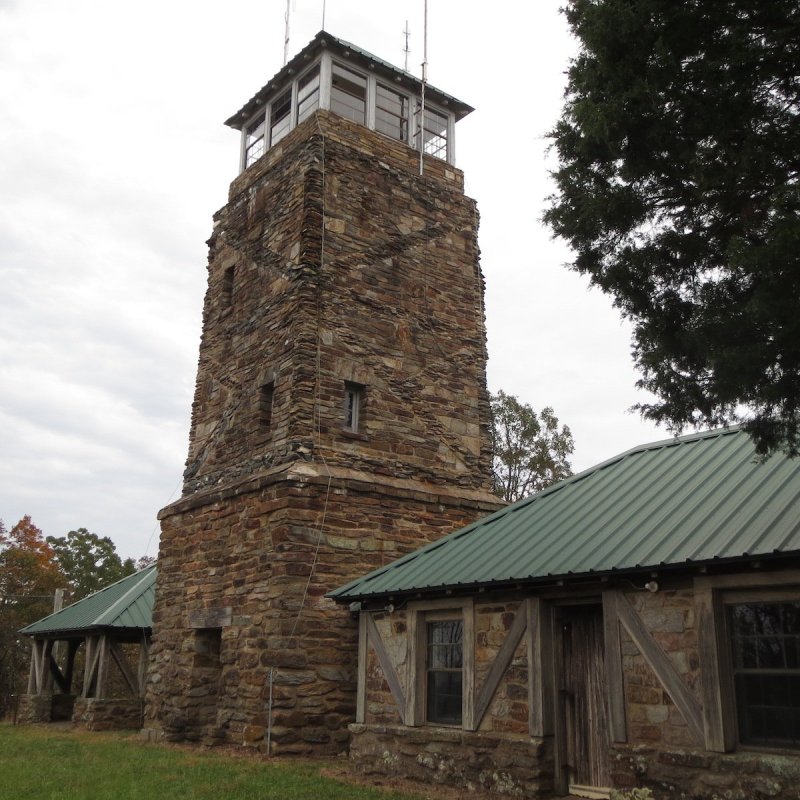
Joe Cuhaj
I first arrived in Weogufka, Alabama, in 2000 to add a new hike to a guidebook I was writing on hiking the state. I was told that the town held a little secret, something only the locals knew about — it was a state park that never was.
Videos by TravelAwaits
I drove up the long, winding dirt road until I reached a ridge just below the summit of Flagg Mountain, which is recognized as the last mountain (or first, depending on your orientation) in the Appalachian Range over 1,000 feet tall. I was amazed at what I found — the remnants of what was to be one of a series of state parks that were being built by the Civilian Conservation Corps in the 1930s — hand-hewn log cabins, many of which were collapsing into themselves to be reclaimed by nature, and a pond with pumphouse that would have provided water to visitors to the park.
As I walked around the ridge and studied the old cabins, I looked up toward the top of the mountain and got my first glimpse of it — the quintessential structure the CCC became known for in state parks across the country: a stone fire tower, its hand-carved rocks carefully and precisely laid one on top of the other. The tower would have provided visitors to this new park panoramic views of the beautiful central Alabama mountains.
I was fortunate on this day. Some locals worked on the tower, trying to repair what they could before this little-known landmark collapsed. They opened its door, and I climbed the rickety staircase to the cab. In the twilight, as the sun was setting, I could see the lights of the state capital, Montgomery, to the south and Birmingham to the north.
I immediately fell in love with Flagg Mountain.
Fast forward 21 years and Flagg Mountain has burst into life with new energy. A tremendous effort has been put forth to save the “state park that never was” and bring it to its full glory. While there is still some work to do, today, Flagg Mountain has been reborn thanks to the efforts of volunteers, non-profit agencies, and the state. It is open for business, inviting hikers, campers, bird watchers, and picnickers to its beautiful summit.

Joe Cuhaj
History Of Flagg Mountain
The year was 1933. A contingent of young men with the CCC came to Weogufka to build the state’s newest state park within the boundaries of Weogufka State Forest. Its centerpiece would be Flagg Mountain.
The CCC set about building several log cabins, an enormous stone dining hall, and on the summit, a 52-foot-tall tower made from 2- to 3-foot-thick hand-carved stones. The cab atop the tower would be a window-laden 12 by 12 affair offering a 360-degree view. CCC officials announced to the world that the park would be “most scenic in the state.”
With the CCC’s disbanding at the outset of World War II, the Flagg Mountain project was abandoned. What was completed was turned over to Alabama Forestry, who manned it until 1989 when they, too, abandoned it, leaving the park’s infrastructure to be reclaimed by nature.

DeForest Tuggle-Flagg Mountain Caretaker
Bringing The Mountain To Life
The interest in bringing Flagg Mountain back to life began when hikers realized that being the southernmost mountain in the Appalachians, it would be possible to connect the mountain to the Appalachian Trail, giving backpackers a chance to hike the entire mountain range from Alabama to Maine and into Canada. While some shorter trails were built around the summit, it wasn’t until 2017 that the Conservation Fund acquired land to protect the Weogufka Creek Gorge (which included Flagg). It was then that Alabama’s famous long trail, the Pinhoti Trail (which had already been connected to the A.T.), was extended to the mountain.
The Alabama Forestry Commission saw what the mountain could be. Volunteers known as the Friends of Flagg Mountain began working on renovating the cabins, brought water and electricity to the mountain top, and began plans to reopen the fire tower.
A caretaker was brought in to watch over the project and keep the buildings secure while they were being renovated. M.J. Eberhart (better known by his hiking moniker, “Nimblewill Nomad”) was the first caretaker. Nomad fell in love with Flagg on his first hike from Florida to Canada on what is known as the Eastern Continental Trail. The route he walked crossed over Flagg Mountain and, like everyone who has ever visited the mountain, fell in love with it.
Eberhart called the volunteers who worked on the cabins “locals,” although they come from towns and cities across the state and the country. When all was said and done, four of the original log cabins had been beautifully restored to their original 1933 glory. The massive stone dining hall next to the fire tower is once again a cozy retreat with its huge stone fireplace. In addition to the Pinhoti Trail, new hiking trails have been added that wind their way through the beautiful mixed hardwood forest of Weogufka State Forest.

Joe Cuhaj
Exploring Flagg Mountain
Today, the mountain’s new caretaker, Dee Tuggle (also known by her hiking name, “Sparkles”), and the Friends of Flagg host regular events atop the mountain that are open to the public, including their monthly “First Friday on Flagg.” The fun gathering is described as an “after work / start-the-weekend” party and is free. Just bring along a covered dish and join the fun and fellowship with hikers and friends.
Besides the Pinhoti Trail, there are other shorter but equally beautiful trails ranging between 1 and 5 miles in length that wind their way around the mountain. These trails offer views of Weogufka Gorge, amazing fall colors, and chances to do a little birding (the mountain is now a stop on the Alabama Birding Trail). A new parking lot has been installed with an ADA-accessible path that meanders through the woods to the tower.
And speaking of the tower, I’ll have more on that in a moment.

Joe Cuhaj
Spending A Night On Flagg Mountain
You’re in for a real treat when you spend a night on top of the mountain, especially in the fall when the autumn leaves are ablaze, or in winter, when there is a light dusting of snow on the ground. Either way, you can cozy up to a warm fire in one of the cabins.

DeForest Tuggle-Flagg Mountain Caretaker
There are four cabins in the park, and they are available on a first-come, first-serve basis. Visit the Friends of Flagg Facebook page for updates on cabin availability. One cabin has a full bathroom and while there is no charge for spending the night, a minimum donation of $90 is requested to help continue improving the site. A second cabin does not have a bathroom (the ranger cabin does) and a $70 donation is requested to spend the night. Both have electricity and fireplaces.
There are plenty of sites available for primitive tent camping where you can pitch your tent and sleep under an incredible starry sky.
Getting There
Flagg Mountain is in the Weogufka State Forest on CC Camp Road. There are two entrances — one to the fire tower, the other to the cabins and primitive campgrounds. Both gates are well marked. Check with the Friends of Flagg for the current hours the gates are open.

Joe Cuhaj
Pro Tips
While the fire tower is physically sound, the wooden stairs inside are dangerous, so access to the top is currently prohibited. The good news is that a contract to repair the stairs has been signed, and work will begin soon to reopen the tower.
Please visit the caretaker, Dee Tuggle, when you go to the mountain to let her know you’re there and learn more about the mountain’s history. You can find her at the ranger cabin.
Related Reading:
